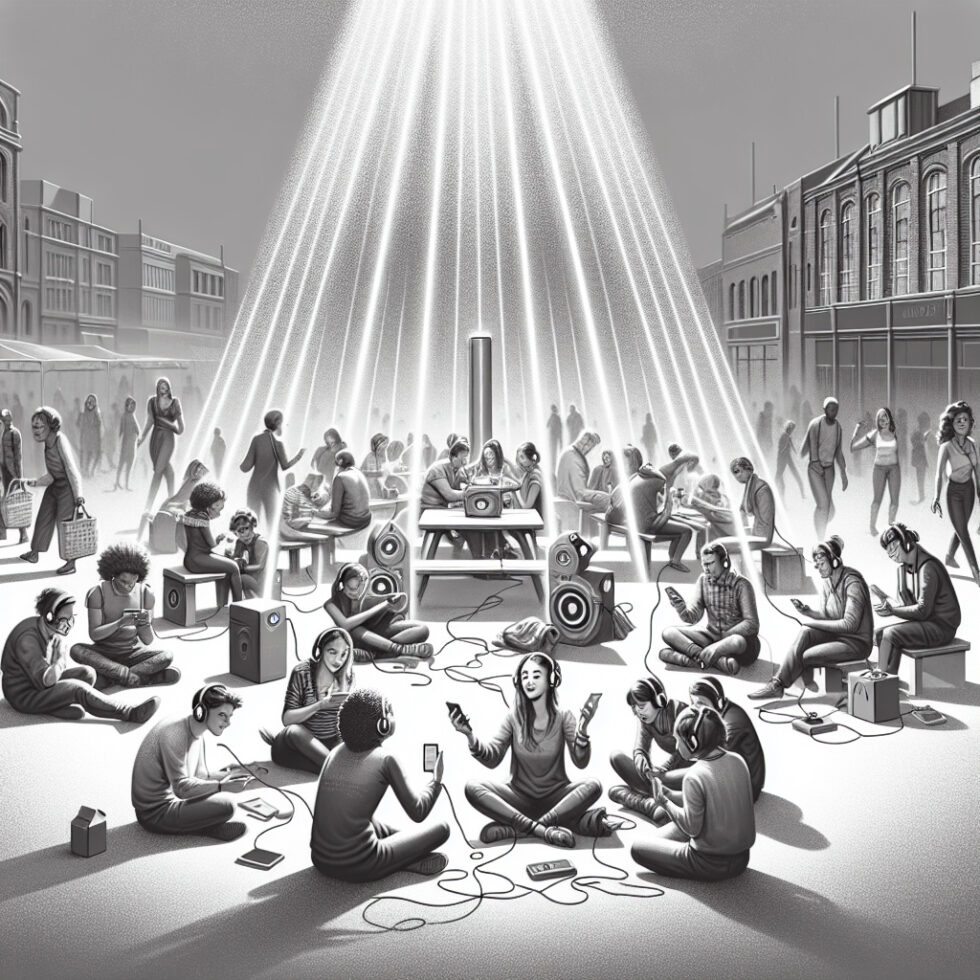
Silent TVs at the gym. Muffled airport announcements. A tour guide you can barely hear. We all have stories like these. Bluetooth LE Audio and Auracast aim to fix them with a simple idea: broadcast audio you can join with your own earbuds, just like connecting to Wi‑Fi. This article explains what’s actually new, how it works in practice, and what to look for as a listener, venue operator, or product builder.
What’s Different About LE Audio and Auracast
Bluetooth has streamed audio for years, but the classic version was built for one-to-one connections and bulky battery usage. LE Audio changes the foundation. It runs on the Bluetooth Low Energy radio, uses a new codec called LC3, and adds smarter ways to send sound to one or many devices at once.
Key building blocks
- LC3 codec: A modern, more efficient audio codec that sounds better than SBC at the same or even lower bitrates. That means cleaner audio with less power.
- Isochronous channels: Time-aligned streams that keep left and right earbuds in sync with low jitter. You’ll see this called Multi-Stream Audio in device features.
- Auracast broadcast audio: One transmitter can broadcast to any number of nearby receivers. No pairing required. It’s like a local radio station you can discover and join.
What Auracast enables
Think of public audio you can actually hear clearly, privately, and in your own language when apps get involved:
- Venues: Airports, gyms, bars, houses of worship, conference centers, and classrooms can broadcast audio channels that anyone nearby can join.
- Accessibility: Hearing aids designed for LE Audio can receive these broadcasts directly, improving clarity without extra accessories.
- Group moments: “Share my audio” for a movie night, a guided museum tour, or a silent disco—all without handed-out headsets.
How Auracast Works, Without the Jargon
With classic Bluetooth, you pair to a specific device and streams are private. Auracast turns the model into discoverable broadcasts. A transmitter advertises that audio is available, your phone or earbuds see the broadcast, and you join a channel.
Joining a broadcast
There are two ways to join:
- Open selection: You scan and see “TV 1,” “Gate A23 Announcements,” “Court 3,” and you tap to join. This is perfect for public content you want to make accessible to anyone nearby.
- Assisted join: You scan a QR code, tap an NFC tag, or use a venue app to jump straight into the right channel. This is faster in busy spaces or when you want a “members only” channel protected with a broadcast code (a simple passphrase).
What’s happening under the hood
You never “pair” with a venue’s hardware. Instead, your device gets timing and channel info from a small advertisement packet, then locks onto the Broadcast Isochronous Stream. The result is low-overhead, low-latency audio designed for crowds—dozens of people can listen without overloading the venue or your phone.
Latency and lip sync
For TV audio in a bar or airport, lip sync matters. LE Audio’s isochronous design and LC3 codec bring latency down to levels that work well for speech and many video scenarios. Real-world latency depends on the whole chain—source device, transmitter, and earbuds—but the system is designed for much smoother sync than past hacks like FM transmitters or ad‑hoc streaming apps.
Who Needs to Upgrade What?
To enjoy broadcast audio, you need both a transmitter in the venue and a receiver on you. The good news: many new phones, laptops, hearing aids, and earbuds are already shipping with Bluetooth 5.2+ radios and LE Audio‑capable chipsets, with software support rolling out over updates.
Listeners: phones, earbuds, and hearing aids
- Bluetooth version: Look for Bluetooth 5.2 or newer. That’s the foundation required for LE Audio features.
- Earbuds/headphones: Confirm “LE Audio,” “LC3,” or “Auracast receive” in the specs, not just “Bluetooth 5.3.” Hardware alone isn’t enough—firmware support matters.
- Phones and laptops: Modern Android devices and Windows 11 have growing support for LE Audio. Check settings or release notes for “LE Audio,” “LC3,” or “Auracast.”
- Hearing aids: Devices labeled for LE Audio will be able to receive broadcasts directly, which is a significant upgrade over loops or neck loops in many situations.
Venues: transmitters and integration
Venues add one or more LE Audio transmitters and connect them to their existing audio sources. Think of it like adding a small box to each TV or tying into a PA system near an information desk.
- Simple setup: For each TV, a transmitter takes HDMI ARC or analog audio and broadcasts a labeled channel like “TV 4.”
- Centralized setup: Larger spaces feed multiple audio sources into a rack-mount device or a small network of transmitters. Signage and QR codes help guests join the right channel fast.
- Assisted listening: If you provide hearing assistance, Auracast can complement or, in some cases, replace older systems. Always check local regulations to ensure compliance and coverage targets.
Real-World Use Cases You Can Deploy Now
Airports and transit hubs
Gate change announcements are often hard to hear. Broadcasting “Gate B17” directly solves that without raising the ambient noise for everyone nearby. You can also offer multiple language tracks in high‑traffic areas—guests choose their language once and keep it “favorited” for their journey.
Fitness centers and sports bars
Every TV can host its own audio stream. Patrons listen to the game they care about with their own earbuds. Staff no longer juggle remote controls or volume battles. Add closed captions on screen and clear audio in ears for an inclusive experience.
Museums and tours
Instead of handing out headsets, guides broadcast to visitors’ own devices. Groups can split up and rejoin without losing the feed. Special events can spin up extra channels for overflow spaces or different languages.
Education and training
Lecture capture, hybrid classes, or quiet study zones become easier. A student sitting far from the lectern can listen to a clean feed. Corporate training can broadcast to conference rooms and breakout areas without running new cables.
Houses of worship and community centers
Provide discreet assisted listening without dedicated receivers. Offer translation channels operated by volunteers using a basic transmitter and a mic feed. Keep the main space calm while giving people choice and clarity.
Planning a Venue Deployment: A Practical Checklist
1) Choose your zones and sources
Start with locations where audio is often missed: entrances, information desks, key displays, and areas with multiple TVs. Map each audio source to a channel name that’s easy to understand. Short, plain labels win: “Lobby Announcements,” “Court 3,” “Stage A.”
2) Pick the right transmitters
- Inputs: HDMI ARC/eARC for TVs, analog for mixers or PA systems.
- Coverage: Most spaces can be covered with a single transmitter per source. Larger rooms may need strategic placement or a few synchronized units.
- Signage support: Good solutions include QR codes, NFC tags, and simple “Join this audio” posters you can customize.
- Management features: For multi‑room venues, look for web consoles to manage channel names, volume levels, and operating hours.
3) Decide on open vs. restricted streams
Public spaces typically use open broadcasts. Private sessions, translation channels, or staff monitors can use a simple broadcast code. QR/NFC helps users join without typing.
4) Test latency and lip sync
Put a phone camera on a TV showing a metronome or sports replay and join the broadcast with common earbuds. Small adjustments in your source path (e.g., bypassing extra audio processing) can significantly improve sync.
5) Plan the guest journey
- Discoverability: Will people scan a QR at each screen or browse channels in an app? Both work; pick one and make signage clear.
- Onboarding: If you have a venue app, add a “Listen here” button that jumps straight into the stream.
- Support: Train staff with a one‑page guide: how to reset a transmitter, rename a channel, and answer “How do I join?”
6) Keep accessibility front and center
Announce that assisted listening is available over Bluetooth in your space. Make sure channel labels and QR codes are visible at wheelchair height and near seating sections reserved for assisted listening. If you already provide hearing loops, keep them; Auracast can complement existing systems and extend coverage to more visitors.
For Listeners: Making Sure Your Gear Is Ready
Check your earbuds and hearing aids
Look for three things: Bluetooth 5.2 or newer, explicit mention of LE Audio or LC3, and firmware notes that talk about Auracast support. If your earbuds support only classic Bluetooth, you can’t join Auracast broadcasts—even if your phone is new.
Check your phone or laptop
On Android and Windows, support is improving quickly. Update your OS and check Bluetooth settings or audio device details. On Android, some manufacturers expose a “LE Audio” toggle in developer options; on Windows, driver updates from your laptop maker can make a difference.
Battery life expectations
LE Audio was designed for lower power. You’ll often see longer battery life compared to classic Bluetooth streaming at similar quality—not a night-and-day change, but meaningful, especially for hearing aids and compact earbuds.
Security, Privacy, and Etiquette
Encryption when you need it
Auracast can be open or protected by a broadcast code. For public announcements and TV audio, open is simplest. For members‑only content, use a code delivered by QR, NFC, or a venue app. Keep in mind: a code protects access but isn’t a license to transmit sensitive data in crowded places.
What others can hear
Broadcasts are designed to be discoverable. That’s the point. But as a listener, your device’s join is local; you aren’t sharing your identity with the venue by default. If you join through a venue app, standard app privacy rules apply.
Noise pollution, solved
Auracast helps reduce the temptation to crank up TV volume or PA systems. It encourages quiet spaces with optional clarity. For staff and guests, that can mean fewer headaches and clearer exchanges.
Designing Better Experiences on Top of Auracast
Names and icons matter
People choose channels by name. Use short, helpful labels and an icon: “Gate A23,” “Court 2,” “Stage B,” “Spanish Translation.” Avoid internal jargon.
Make joining instant
QR codes near each source are the fastest route. Place them within arm’s reach. If you have digital signage, show a quick “Scan to listen” prompt with a rotating QR for each channel.
Multiple languages and roles
Broadcast the main language plus translations. It’s okay to run multiple channels with identical timing. Add bilingual square signage for clarity: language name, channel name, and a simple icon for “headphones.”
Tour operators and educators
Portable transmitters make it easy to run small-group sessions. If you move between exhibits or rooms, use a sticker with your channel name on a clipboard or lanyard so latecomers can scan and join quietly.
Common Pitfalls and How to Avoid Them
“We bought Bluetooth 5.3; why doesn’t it work?”
Version numbers alone are not guarantees. You need LE Audio firmware and Auracast support on both the transmitter and the receiving device. Always confirm support in product pages or release notes, not just radio versions.
Wi‑Fi interference worries
LE Audio shares the 2.4 GHz band but is designed to play nicely with Wi‑Fi. In practice, problems are rare when transmitters aren’t crammed together. Leave a bit of space between units, avoid metal enclosures, and don’t stack gear on top of Wi‑Fi routers.
Lip sync on older TVs
Some TV outputs add processing delays. If lip sync bothers guests, try a different output path (e.g., audio out from the set‑top box or eARC from the TV into a transmitter that supports it). Keeping the chain simple usually helps.
Channel overload
Listing fifteen channels in a small area is confusing. Start with the essentials, choose a consistent naming scheme, and use QR codes to jump directly. You can always add more once guests are comfortable with the idea.
What Builders and Product Teams Should Know
Chipset and stack support
LE Audio relies on radio and firmware support for LC3, Isochronous Channels, and Broadcast Audio. Many contemporary Bluetooth SoCs from major vendors include these features, but production firmware may enable them over time. If you’re building devices, confirm the entire stack: codec, scheduling, sync, and controller/host interfaces.
Assisted joining UX
Offer robust QR/NFC flows and fall back to broadcast scanning. Show channel names, signal quality, and simple language tags. Support favorites and remembered venues so users can rejoin with one tap on return visits.
Compliance and accessibility
Broadcast audio can extend assistive listening in places that don’t support hearing loops or where loops are impractical. Publish a short accessibility note on your website: where broadcasts are available, how to join, and who to contact for support.
Security choices
For private events or paid content, require a broadcast code and rotate it periodically. Avoid streaming confidential voice or personally identifying data over public broadcasts. When in doubt, treat Auracast like a local radio station with optional lock, not a secure phone call.
What to Buy: Quick Recommendations
Consumers and travelers
- Earbuds/headphones: Models that advertise “LE Audio” or “Auracast” support. Check for LC3 in specs and verify with the manufacturer’s support notes.
- Phone/laptop: Keep your OS up to date. On Android and Windows 11, LE Audio support often arrives via system and driver updates.
- Backup plan: If your current earbuds don’t support LE Audio yet, carry a small wired headset. Many venues will also keep a few receivers on hand for guests without compatible devices.
Venues and operators
- Transmitter per source: One for each TV or audio zone. For complex spaces, look for multi‑input, rack‑mount options.
- Signage kit: QR/NFC tags, printed instructions, and a page on your website or app that explains joining in one or two steps.
- Monitoring: A simple dashboard to see active channels, signal metrics, and device health helps staff troubleshoot quickly.
The Payoff: Clearer Audio, Quieter Spaces, Happier People
Auracast and LE Audio take the friction out of listening in public. People use the earbuds they already carry. Venues reduce noise and complaints. Hearing aid users get direct, high‑quality access. And for builders, new audio experiences emerge: shared movie nights, pop‑up screenings, docent tours, and quietly accessible announcements that respect everyone’s ears.
We’re early in the adoption curve, so you’ll still encounter mixed support. That’s normal. The important part is that the foundation is in place—a common standard, broad chipset support, and OS integrations rolling out. You don’t have to wait for a perfect checkmark on every device to start making everyday audio better. Begin where the need is highest, make joining obvious, and keep it simple.
Summary:
- LE Audio moves Bluetooth streaming to a more efficient codec (LC3) and synchronized, low‑latency channels.
- Auracast enables broadcast audio that anyone nearby can join without pairing, ideal for venues and accessibility.
- Listeners need LE Audio‑capable earbuds or hearing aids and up‑to‑date phones/laptops to receive broadcasts.
- Venues add transmitters per audio source, label channels clearly, and use QR/NFC for fast, friendly joining.
- Security is optional via broadcast codes; open broadcasts are best for public content and announcements.
- Start with high‑need zones (airports, gyms, museums, classrooms), test lip sync, and keep channel names simple.
- As support grows across devices and OSs, shared wireless audio will make public spaces clearer and quieter.





